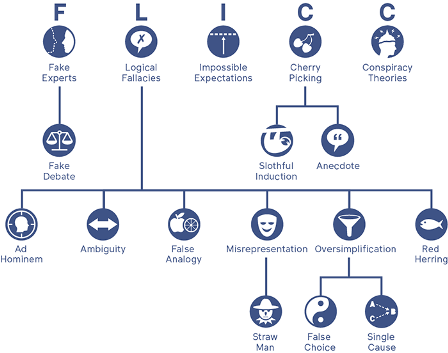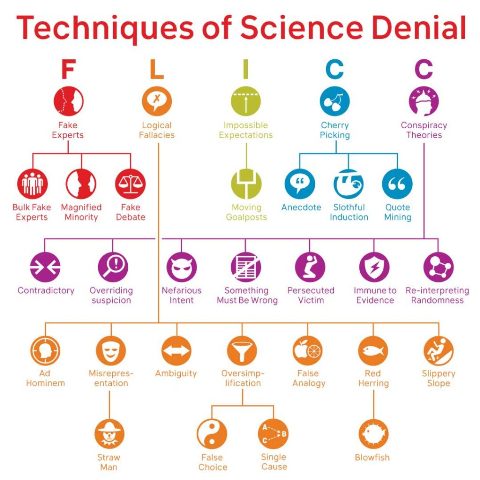File:FLICC techniques of science denial.png
FLICC_techniques_of_science_denial.png (448 × 353 pixels, file size: 46 KB, MIME type: image/png)
From Video by John Cook as he explains what he calls the 'Five Characteristics of Science Denial'.
You can remember them with the acronym “FLICC” -- Fake Experts, Logical Fallacies, Impossible Expectations, Cherry Picking, and Conspiracy Theories.
“First, fake experts are used to create the impression of an ongoing scientific debate. The general public rely on expert opinion as a guide for their own beliefs about science. For this reason, casting doubt on a scientific consensus is a key strategy for those looking to manufacture doubt about the science. Fake experts appear to be highly qualified but don’t have actual expertise in the relevant scientific field […]
Number two is logical fallacies. These are logically false arguments that lead to an invalid conclusion. […]
The third characteristic of science denial involves impossible expectations. This demands unrealistic standards of proof before acting on the science. […]
Fourth is cherry picking, which focuses on specific pieces of data, often out of context, while excluding any data that conflicts with the desired conclusion. […]
Fifth, when someone disagrees with an overwhelming scientific consensus, there is always the resort to conspiracy theories tactic. Attempt to undermine the facts, evidence and science by introducing a conspiracy theory. […]
~
Background
A history of FLICC: the 5 techniques of science denial
by John Cook
Founder of skepticalscience.com / https://skepticalscience.com/
In 2007, Mark Hoofnagle suggested on his Science Blog Denialism that denialists across a range of topics such as climate change, evolution, & HIV/AIDS all employed the same rhetorical tactics to sow confusion. The five general tactics were conspiracy, selectivity (cherry-picking), fake experts, impossible expectations (also known as moving goalposts), and general fallacies of logic.
Two years later, Pascal Diethelm and Martin McKee published an article in the scientific journal European Journal of Public Health titled Denialism: what is it and how should scientists respond? They further fleshed out Hoofnagle’s five denialist tactics and argued that we should expose to public scrutiny the tactics of denial, identifying them for what they are. I took this advice to heart and began including the five denialist tactics in my own talks about climate misinformation.
In 2013, the Australian Youth Climate Coalition invited me to give a workshop about climate misinformation at their annual summit. As I prepared my presentation, I mused on whether the five denial techniques could be adapted into a sticky, easy-to-remember acronym. I vividly remember my first attempt: beginning with Fake Experts, Unrealistic Expectations, Cherry Picking… realizing I was going in a problematic direction for a workshop for young participants. I started over and settled on FLICC: Fake experts, Logical fallacies, Impossible expectations, Cherry picking, and Conspiracy theories.
~
File history
Click on a date/time to view the file as it appeared at that time.
| Date/Time | Thumbnail | Dimensions | User | Comment | |
|---|---|---|---|---|---|
| current | 22:46, 16 June 2020 |  | 448 × 353 (46 KB) | Siterunner (talk | contribs) |
You cannot overwrite this file.
File usage
The following 4 pages use this file:

